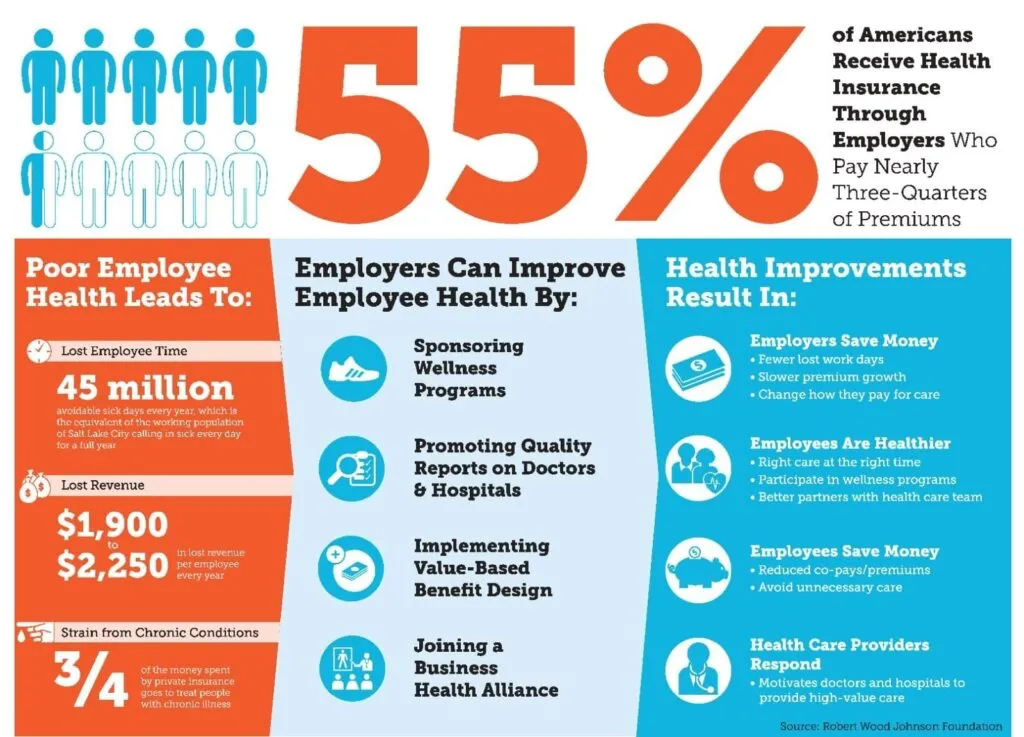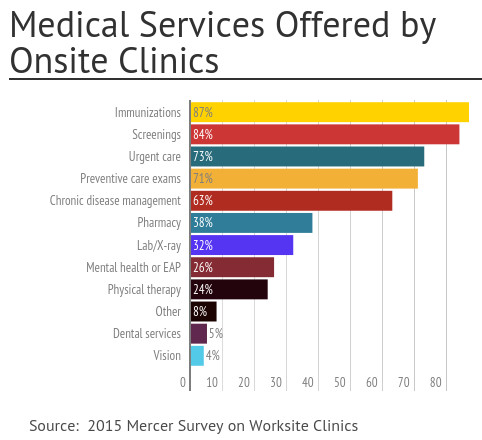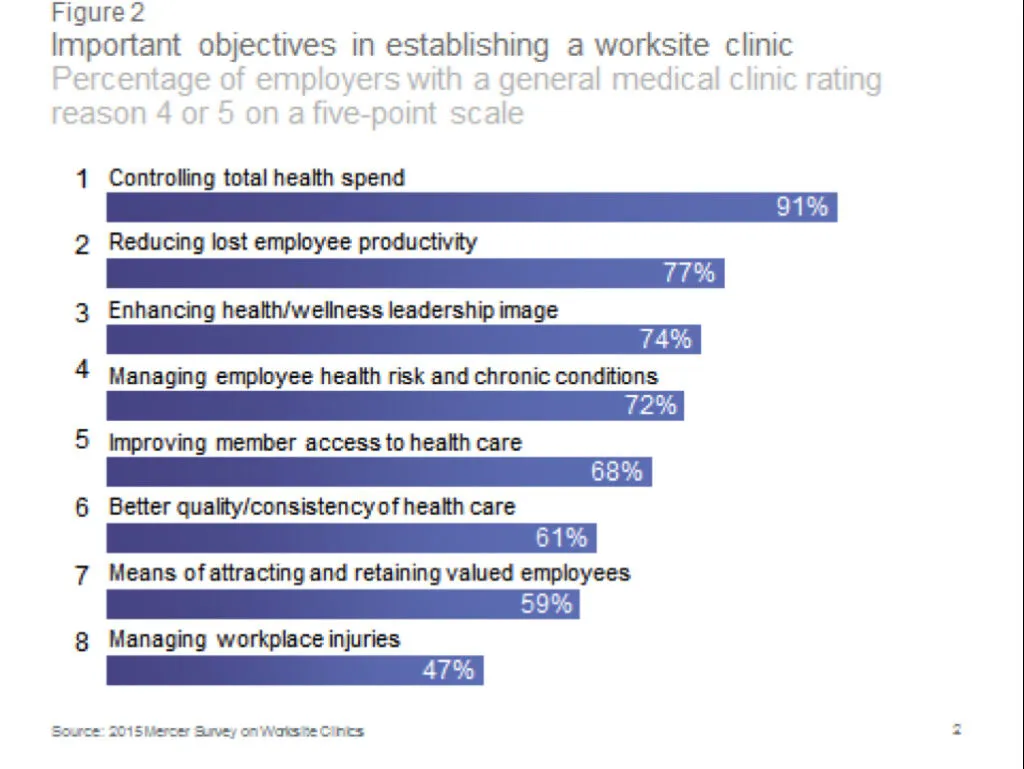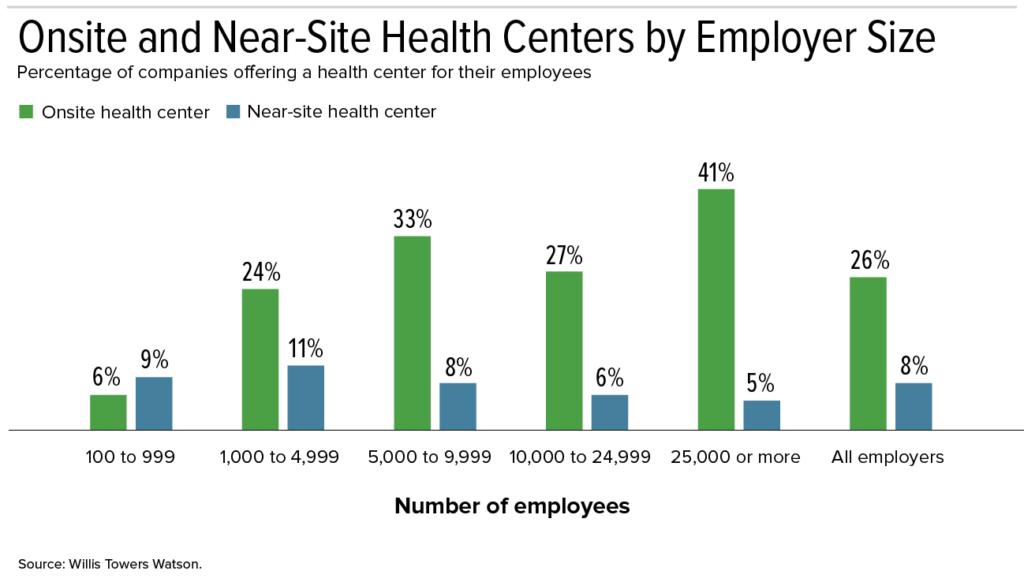This post was co-authored with Mike Russo, CSP & Senior Vice President at JobSiteCare.
In the fast-paced and demanding environments of many workplaces, injuries can happen unexpectedly. When they do, the speed and quality of the response hold significant weight for the injured employee, their recovery, and overall company operations. However, not all workplaces have the immediate access to specialized medical care that these situations often demand. This gap in care is what occupational health clinics aim to fill.
In this blog, we’ll examine what occupational health clinics are, the services they provide, their benefits, and whether they’re the right fit for your business and workplace injury management strategy.
What is an Occupational Health Clinic?
Occupational health clinics are specialized medical facilities that focus on preventing, diagnosing, and treating illnesses and injuries related to the workplace. They prioritize understanding the specific hazards and demands of your work environment to provide tailored care for your workforce.
Occupational Health Clinics vs. Primary Care
While both focus on keeping people healthy, occupational health and primary care have distinct focuses:
- Occupational Health Clinics: Specialize in work-related health concerns. This includes treating sudden workplace injuries, conducting pre-employment physicals, managing ongoing conditions that could affect job performance, and designing preventative programs specific to workplace risks.
- Primary Care Clinics: Handle general health needs like checkups, vaccinations, and managing chronic conditions. They have a broader scope but may lack the in-depth understanding of workplace hazards and regulations needed for specialized occupational healthcare.
Common Clinic Models
- Full Clinic: May include doctors, nurses, and physical therapists. They provide a wide range of services, from on-site injury treatment and physical therapy to drug testing and work-related physical exams.
- Nurse-Led Model: A registered nurse provides first aid, assesses injuries, manages return-to-work programs, and administers vaccinations and health screenings. This is a cost-effective option for smaller workplaces.
- Physical Therapist/Athletic Trainer Model: Focuses on workplace injury prevention, ergonomic assessments, and rehabilitation. They design programs to help employees reduce injury risks and recover faster.
- Episodic Care: This on-demand model brings occupational health services to your workplace for specific needs on a one-time or recurring basis. Think of it as healthcare “pop-ups” that offer services like screenings, vaccinations, and testing without a permanent clinic.

What are Occupational Health Clinic Services?
Occupational health clinics provide various services tailored to the workplace’s health and safety regulations and needs. These services fall within the following 4 key areas:
1. Injury Treatment and Management
- First aid in the workplace and immediate care: Clinics are equipped to handle various work-related injuries, from minor cuts and sprains to more serious incidents.
- Wound care: Proper wound cleaning, dressing, and ongoing treatment to promote healing and minimize infection risk.
- Return-to-work programs: Clinicians develop personalized plans to help injured employees safely return to their job duties, potentially including modified work arrangements and rehabilitation.
2. Preventive Services
- Pre-Employment Physicals: Assessments to determine if a worker is physically capable of performing the job’s demands, helping reduce the risk of injuries.
- Health Screenings: Clinics can offer blood pressure checks, cholesterol monitoring, vision tests, and other screenings to identify potential health risks early on.
- Vaccinations: Protection against illnesses like the flu or tetanus, which are especially relevant in certain industries.
- Ergonomic Assessments: Evaluations of workstations and job tasks to identify and address risk factors for musculoskeletal injuries.
3. Compliance and Regulatory Services
- Drug and Alcohol Testing: Screening programs (pre-employment, random, post-accident) in accordance with industry and legal requirements.
- Respirator Fit Testing: Ensuring proper fit and function of respiratory protective equipment, which is important in many workplaces.
- OSHA-Mandated Exams: Physical examinations required by OSHA regulations for specific occupations with exposure to hazards such as noise or chemicals.
4. Additional Services
- Wellness Programs: Initiatives designed to promote healthy habits among employees, potentially encompassing nutrition counseling, smoking cessation resources, or fitness classes.
- Travel Medicine: Consultations and vaccinations for employees traveling internationally for work.
- Mental Health Support: Some clinics may provide counseling or referrals for employees experiencing stress, anxiety, or other mental health concerns affecting work performance.

Benefits of Occupational Health Clinics
Occupational health clinics offer a range of advantages for both employees and employers:
Benefits for Employees
- Convenient Access to Care: Onsite or near-site clinics eliminate the need for time-consuming travel to offsite medical facilities. This means employees are more likely to seek treatment promptly, improving health outcomes.
- Specialized Expertise: Occupational health specialists have extensive knowledge of workplace injuries and illnesses. They offer tailored treatment plans designed to promote a safe and quick return to work.
- Focus on Recovery and Returning to Work: These clinics understand the importance of getting employees back to their jobs as soon as it’s medically appropriate. Their treatment plans prioritize recovery while fostering a sense of support for the employee.
Benefits for Employers
- Reduced Injury Costs: Occupational health clinics help prevent workplace injuries through safety management systems and programs, and by treating injuries early, they minimize severity and the associated costs. Efficient return-to-work programs further reduce expenses.
- Improved Productivity: Healthy employees are more productive employees. Services provided by industrial athletic trainers, such as tailored injury prevention programs, enhance worker well-being and ensure quick treatment, contributing to a more efficient workplace.
- Enhanced Workplace Safety: These clinics can identify potential workplace hazards and recommend solutions to prevent injuries, creating a safer and more compliant workplace.
- Streamlined Workers’ Compensation Process: Occupational health professionals are familiar with workers’ compensation regulations and help ensure smooth claim management, saving employers time and resources.
- Regulatory Compliance: Occupational health professionals stay up to date on industry regulations (such as OSHA and DOT), ensuring that employers meet all legal requirements for workplace health and safety.

Are Occupational Health Clinics Right for Your Workforce?
While these types of clinic solutions offer clear advantages, there are some aspects to consider.
Limitations of Traditional Occupational Health Clinics
- Geographic Restrictions: Unlike on-site healthcare, traditional brick-and-mortar clinics can pose a challenge for remote worksites or for businesses with employees spread across multiple locations.
- Limited Hours: Clinics may have restricted operating hours, making access difficult for employees working outside of standard business hours.
- Specialist Availability: Smaller clinics may not have a wide range of specialists on staff, potentially requiring referrals to external providers, which can lead to delays in care.
- Potential for Over-referral: In some cases, onsite clinics might be inclined to over-refer employees for unnecessary visits or treatments to meet productivity targets, potentially increasing costs for employers.
JobSiteCare addresses the shortcomings through a unique approach:
- Telemedicine Accessibility: Our board-certified physicians are available 24/7, eliminating geographical barriers and ensuring prompt workplace injury care whenever and wherever needed.
- Reduced Unnecessary Referrals: Telemedicine consultations often reduce in-person referrals, saving time and costs for employees and employers.
- Wide-Ranging Expertise: JobSiteCare connects employees with a diverse network of specialists, ensuring access to the right care for every situation.
- Holistic Approach: Alongside treatment, our physicians follow up regularly, as well as coordinate all aspects of care for a healthy return to work.

Choosing the Right Occupational Health Solution
To ensure you get the maximum benefits, ask the following questions when selecting a clinic or provider:
- Accessibility: How readily can employees access care? Are services available outside of regular business hours and for those in different locations?
- Scope of Services: Does the provider go beyond basic injury treatment to offer preventative health measures, workers’ compensation assistance, and wellness support?
- Expertise: Are the healthcare professionals board-certified in occupational medicine, and do they have a deep understanding of your specific industry and potential workplace hazards?
- Technology: Does the provider use technology to streamline processes, offer remote consultations, and enhance the patient experience?
Need Better Workplace Injury Care? Experience the JobSiteCare Difference
Occupational health clinics have played an important role in keeping workers safe and productive. However, the evolving needs of modern workplaces demand new levels of flexibility and expertise. If your business struggles with the accessibility issues of traditional models or seeks solutions that go beyond standard care, it’s time to consider a different approach.
JobSiteCare transforms the landscape of workplace injury solutions. We deliver a model focused on convenience, expertise, and proactive support by offering both physician-led telemedicine and onsite medical services to provide the ideal fit for your workplace. To find out more, schedule a free consultation today.
Frequently Asked Questions
Are all occupational health clinics the same?
No, occupational health clinics can differ in several ways. Some clinics might focus on specific industries or types of injuries, while others offer a broader range of services. The staffing models (nurse-led vs. physician-led), technology used, and emphasis on return-to-work programs can also vary between clinics.
Can onsite occupational health clinics operate on a distributed worksite?
Traditional onsite clinics are best suited for workplaces with a centralized location. For distributed worksites, telemedicine-based occupational health solutions like JobSiteCare offer a more flexible and accessible option. These solutions can provide immediate injury care and physician consultations, regardless of an employee’s location.
How does an occupational health clinic ensure compliance with regulations?
Occupational health clinics stay updated on industry-specific regulations, including those from OSHA, DOT, and other governing bodies. They implement protocols, conduct regular training for their staff, and may even assist clients with understanding and navigating complex regulatory requirements.
Is there an alternative for occupational health clinics?
Yes, solutions like JobSiteCare offer an innovative alternative. We combine telemedicine for real-time injury care with a network of specialists, offering convenience and flexibility without requiring a fully staffed onsite clinic.


